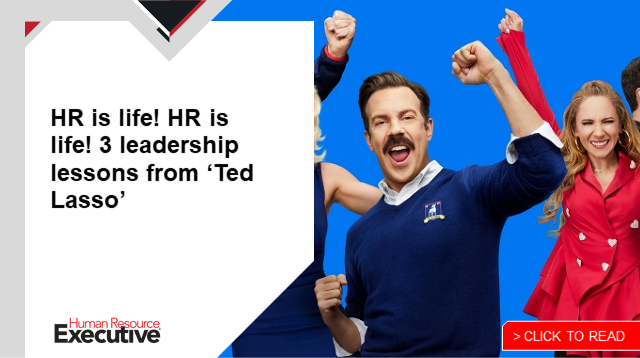As 2022 gets underway and employees’ expectations continue to evolve, employers are racing to develop future-of-work plans that take into account what their workforces want—and flexibility will likely be at the heart of them. While policies can help formalize an employer’s approach to flexibility and hybrid or remote work, employers shouldn’t overlook another key element: leaders and managers.
Flexibility should be personalized, and that’s where leaders and managers can be vital, says Michelle O’Hara, executive vice president and CHRO at SAIC, a Fortune 500 IT company that employs more than 25,000 people. O’Hara says this approach recognizes that how and where people work can directly impact their wellbeing, a primary focus of SAIC as it, like most organizations today, tries to weather the storm that is the “Great Resignation.”
O’Hara—formerly an HR and recruiting leader at firms including BearingPoint, Perot Systems Corp. and Booz Allen Hamilton—recently shared with HRE what the company is doing to reduce turnover risk and take on the other HR challenges on the horizon this year.
HRE: How has SAIC sought to solicit and incorporate employee feedback into the redesign of your employee benefits? How does this listening strategy compare to pre-pandemic?
O’Hara: Employee feedback has always been and continues to be an integral part of our decision–making at SAIC. We know our employees are feeling the impact of the pandemic, racial and social unrest,and other challenges while managing their own responsibilities. Listening to and empathizing with our employees is more important than ever and critical to informing how our company fosters employee wellbeing. Hence, we have made an even more concerted effort to utilize ongoing feedback channels,including regular leadership forums, our employee resource groups, virtual town hall meetings and employee surveys. Ourleaders are alsoincreasing their individual efforts to consistently and frequently communicate and engage with their own employees.Employee feedback weighed heavily on recent decisions to enhance our employee benefits because we view benefits as a key investment back in our people. Highlights of these enhancements include expansion of flexible work schedule options—including a four-day work week, increased family leave and the addition of Juneteenth as a company holiday.
HRE: Are there any impacts of the pandemic on SAIC’s HR strategy that you think will strengthen the function in the long term?
 O’Hara: We are the first generation of leaders in the history of corporate America to manage through such a global crisis.The strength of their leadership, the wellbeing of their employees, and the resilience and adaptability of their culture are becoming hallmarks of successful companies.SAIC’s HR strategy has evolved accordingly, with the HR function now positioned as a critical driver for growth. Our growth strategy is directly aligned with our people strategy, which is centered around SAIC’s leaderscreating a differentiated employee experience that helps our people be and do their best. This means every single leader at every level in the company has to be accountable to our people. No longer is this viewed as solely an “HR issue.” There will be lasting positive effects from this shift, as we all take collective ownership and recognize that human capital equates to financial capital. It’s great to see our company looking to our HR function for strategic thought leadership in this area, and we’re rising to the occasion by upgrading our capabilitiesfor the future.
O’Hara: We are the first generation of leaders in the history of corporate America to manage through such a global crisis.The strength of their leadership, the wellbeing of their employees, and the resilience and adaptability of their culture are becoming hallmarks of successful companies.SAIC’s HR strategy has evolved accordingly, with the HR function now positioned as a critical driver for growth. Our growth strategy is directly aligned with our people strategy, which is centered around SAIC’s leaderscreating a differentiated employee experience that helps our people be and do their best. This means every single leader at every level in the company has to be accountable to our people. No longer is this viewed as solely an “HR issue.” There will be lasting positive effects from this shift, as we all take collective ownership and recognize that human capital equates to financial capital. It’s great to see our company looking to our HR function for strategic thought leadership in this area, and we’re rising to the occasion by upgrading our capabilitiesfor the future.
HRE: The “Great Resignation” is on many HR leaders’ minds today. Is there one particular area of your HR strategy where you’re most concentrating efforts to reduce the turnover risk?
O’Hara: We are doubling down on our focus on employee wellbeing to mitigate turnover, with flexibility as a key differentiator of our HR strategy. We heard from our employees that they value having as much optionality and choice as possible when it comes to flexible work. So, in order for flexibility to be impactful, it has to be personalized in some way. Determining what flexibility looks like for each of our 26,000 employees can’t be done through a single policy. It has to be the responsibility of each of our 3,500 leaders. Offering flexibility at scale is not easy, but neither is being bold and transformational. Ultimately, we believe the effort is well worth it to increase productivity, prevent burnout and foster employee wellbeing. Having our leaders as touchpoints foremployees on flexibility also reflects the fact that leaders are often the mainreason why employees choose to leave. Empowering our leaders to drive flexibility puts them in a great position to impact retention of their employees.
See also: Why 2022 will demand deeper action on wellbeing
HRE: As the HR leader of a tech organization, how are you utilizing emerging technologies to enhance the capacity of your HR team to meet employees’ needs?
O’Hara: SAIC’s expertise in digital transformation solutionsinspires our HR organization to be digitallyfocused. Digitizing our employee experience has been a key pillar of our strategy for yearsto create a contemporary, mobile-enabled and consumer-like experience.We were early adopters of robotic process automation to speed up routine tasks in the HR lifecycle and artificial intelligence in talent acquisition to be more inclusive and efficient. This served us well when the pandemic hit and we had to quickly shiftto a remote virtual environment. Also, change management is also vital to implementing new technology. A great example of this is when we transitioned to a fully virtual new employee orientation a couple of years ago. We were ahead of the industry, and some questioned whether the experience would be as meaningful.To ensure a meaningful experience, we asked our leaders to take time to connect with new employees on day one, week one, month one and beyond. Whether it’s via Zoom, a phone callor an in-person lunch or gathering, make it a point to connect regularly with your people.
HRE: What do you think should be HR leaders’ top priority as 2022 gets underway?
 O’Hara: I can’t think of a more important time for HR leaders. We impact the professional and personal lives of our people, which ultimately impacts the performance and success of our companies. Only 35% of American workers strongly believe their companies care about their wellbeing, sothathas to be a priority. There is a clear correlation between employees’ wellbeing, their performance at work and whether they choose to stay. When you have wellbeing in the workplace, it brings out the best in people and ultimately, that is good for business.At SAIC, we make a linkage between wellbeing, flexibility and inclusion. When you can give employees the flexibility to manage what happens both inside and outside work, it creates a more inclusive environment,with more employees able to engage in a healthy way.In addition, upskilling ourleaders in coaching and empathy, expanding flexible work schedules, increasing diversity in our leadership and other people-related imperatives are all done with promoting wellbeing in mind.
O’Hara: I can’t think of a more important time for HR leaders. We impact the professional and personal lives of our people, which ultimately impacts the performance and success of our companies. Only 35% of American workers strongly believe their companies care about their wellbeing, sothathas to be a priority. There is a clear correlation between employees’ wellbeing, their performance at work and whether they choose to stay. When you have wellbeing in the workplace, it brings out the best in people and ultimately, that is good for business.At SAIC, we make a linkage between wellbeing, flexibility and inclusion. When you can give employees the flexibility to manage what happens both inside and outside work, it creates a more inclusive environment,with more employees able to engage in a healthy way.In addition, upskilling ourleaders in coaching and empathy, expanding flexible work schedules, increasing diversity in our leadership and other people-related imperatives are all done with promoting wellbeing in mind.
HRE: I saw that you studied chemistry in college—how did you make the pivot to HR?
O’Hara: Early in my career, I stumbled into a job in talent acquisition. It was during the dot.com era, which was a great time to be a recruiter, and I never looked back. Eventually, I had opportunities to expand and rotate into other parts of HR, which gave me even more appreciation for our profession. I am tremendously proud to serve as an HR professional. Studying chemistry gave me an eye for analytics and problem-solving that hasshaped my data-informed and solutions-oriented approach to HR. If you think about chemistry as fundamentally an analysis of how substances interact, combine and change to form new substances, you can apply that same type of thinking to how people interact, combine and change. The “chemistry”within an organization’s culture is a powerful thing.
Read more Insights from a CHRO here.
HRE: What is something your colleagues might be surprised to learn about your life or interests outside of work?
O’Hara: It may be a surprise to know that there aren’t actually a lot of surprises. Myactivities outside of work tend to be fairly simple: watching TV with my kids, having a glass of wine with my husband, taking some quiet time off to the side… anything that supports relaxation, which supports wellbeing!